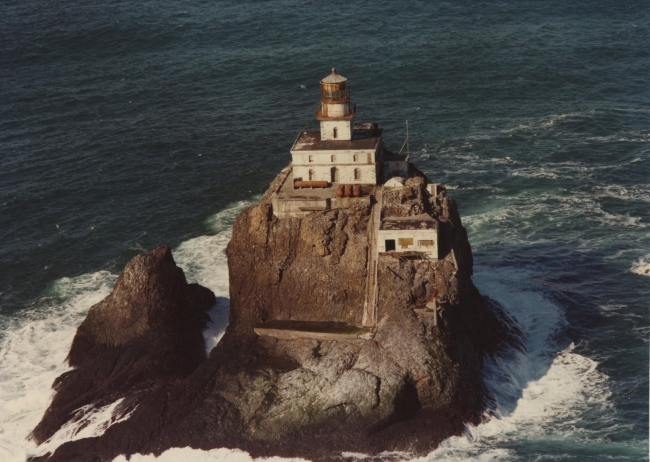Just a little over a mile off the rugged Oregon Coast just off of Cannon Beach near Tillamook, Oregon, sits the Tillamook Rock Lighthouse. Protruding from the angry, gray waves like a terrible sea monster, this nationally recognized historical landmark sits on less than one acre of solid basalt rock. This breathtaking location has been the center of controversy since its very beginning. Long before the lighthouse was ever conceived, the local Native Americans believed that there were tunnels under the sea housing evil spirits that would come to the surface. With the shear cliffs and angry ocean water lapping away at the lighthouse, this structure still stands as a symbol of the precarious line between mighty human endeavor and the forces of mother nature. This story began
in 1878 when Congress appropriated $50,000 for a lighthouse to be built in this section of the Oregon Coast. Upon further review, the original location was deemed unacceptable and so other options were further investigated. In June of 1879, H.S. Wheeler took a small boat out to the rock to determine if placing the lighthouse on the rock would be feasible. Heavy seas made his attempt difficult but it was eventually achieved.
Upon careful inspection, Mr. Wheeler declared the rock could indeed be utilized, thus beginning a monumental undertaking of building a lighthouse on the large, formidable rock. The first death occurred when the surveyor, John R. Trewavas, attempted to step
onto the rock out of the boat, but slipped and fell into the churning ice cold water. Numerous attempts were made to recover him but he was swept away and his body never recovered. Following his death, public outrage began deeming the lighthouse project to be “dangerous, fool hardy and a waste of money,” resulting in the locals refusal to help in the project. The concern over the desperate need of a lighthouse in this area outweighed the public opinion, so the project was begun in secret beginning October 21, 1879. The first project was to construct a mode of transportation between the steamer and the rock for the workers, crews and supplies. They hastily rigged a “breeches buoy,” which consisted of a life ring and a pair of pants cut off at the knees. It was impossible to keep the line taut with the steamer rolling and pitching with the churning seas, so it was expected to get wet in the icy water. Over the years, the crews improved the device. This same type of device was used until the lighthouse was decommissioned in 1957. In seven months, 4,600 cubic yards of rock had been blasted to create a pad for the lighthouse. Despite the frequent storms, small work crews and poor living conditions, the lighthouse was finished in 575 days. According to historical documentation, just twelve days prior to opening the lighthouse a ship, the Lupita, broke apart near the lighthouse during one of the frequent storms killing all 16 members of its crew. Due the howling gale force winds, their cries for help were not acknowledged. The lighthouse workers found the wreckage the following morning. On January 11,1881 the Fresnel lens was lit for the first time. This lighthouse was fully operational from 1881 to 1957 when it was decommissioned in 1957. During the time of its operation, typically a light keeper and four assistants were assigned to the rock. If they had families, they stayed ashore. None of their families were ever allowed to visit the lighthouse due to the cramped and dangerous conditions. The living conditions did prove to be very harsh for the crews taxing their mental and physical stability, so a rotation of crews were implemented with the crews working forty two days on and twenty one days off. Even with the rotation in place, the crews still became tense and at times hostile due to cramped living quarters and frequent storms. Reports of confrontations and turmoil between the crews quickly surfaced giving the lighthouse the nick name of “Terrible Tilly.” Any crew member who caused any trouble was quickly removed from the lighthouse. The only known death of a crew member occurred on August 2, 1911. Assistant Light Keeper Thomas Jones fell thirty five feet to his death on the rocks below while painting the derrick. Although his death was not sudden, he quickly succumbed to his injuries. The lighthouse shone her light for seventy seven years until she was eventually replaced by a red whistle buoy anchored one mile away. Keeper Oswald Allick, who served 20 years, turned her light off for the last time on September 1, 1957. Today, you can read his final log entry on display at the Columbia River Maritime Museum in Astoria, Oregon. The lighthouse was bought and sold two different times until 1978 when Max Schillock Jr. purchased it for $27,000. His title was later forced to cede his ownership to Joy Goolsby whom he reportedly swindled for a large sum of money from. The structure was then resold and gutted turning it into the Eternity at Sea Columbarium, a location where families of deceased sea captains or light keepers could place their urns to rest. The only mode of transportation to do this is by helicopter. At the time, it proved to be a somewhat profitable business venture, but it has since been closed down to the public citing health and safety issues to the public. Today, the United States Fish and Wildlife Service oversees the lighthouse and now the lighthouse is once again home to the local birds and sea lions. To this day, it is said that only 30 urns have been placed there, with two of them being stolen. Along with the urns, the only remnants of the past that remain are the ghosts of the past. Reports from the locals state that on occasion a ghost ship is seen off in the distance during storms. It disappears as quickly as it appears. Other reports tell of an unexplained ghostly light from inside the tower as well as unexplained voices, footsteps and an apparition of a light keeper who walks up and down the stairs to the tower. Since the closure of the lighthouse, new reports are few and far between, but locals still report seeing the ghostly light in the tower on occasion. As I stand on the shore looking out across the cold, gray water, a sense of sadness sweeps over me. A sadness knowing that this once majestic icon now sits empty and isolated with nothing but the dedicated souls who once called the sea their home. -Deborah Frediani- Founder/Case Manager of Visions Paranormal Society
























